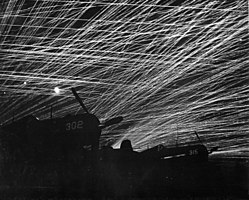Yomitan Auxiliary Airfield
Yontan Airfield (also known as Yomitan Auxiliary Airfield) is a former military airfield on Okinawa, located Yomitan, Okinawa Village on the Okinawa western coast. It was closed in July 1996 and turned over to the Japanese government in December 2006. Today it is home to the Yomitan Village Office and community complex, including baseball fields, running tracks, and community facilities.[1]
| Yontan Airfield Yontan Air Base Yontan Auxiliary Airfield | |
|---|---|
| Okinawa, Ryukyu Islands, Japan | |
 A view of Yontan Air Field looking northeast in 1945 with the East China Sea in the background | |
| Coordinates | 26°23′36.83″N 127°44′48.12″E |
| Type | Military airfield |
| Site information | |
| Controlled by | United States Air Force United States Navy United States Marine Corps |
| Site history | |
| Built | 1944 |
| Built by | Imperial Japanese Army |
| In use | 1945–2006 |
Yontan (Yomitan) Airfield was originally established by Imperial Japanese Army in 1944 as Kita Airfield (北飛行場, Kita Hikōjō). During the Battle of Okinawa on April 1, 1945, United States Marine Corps and United States Army forces seized the airfield on the first day of the landing. It was quickly repaired and became the first airfield on Okinawa to be used by the American forces. Later, it was developed into a major American base for Army, Marine, and Navy aircraft. The Boeing B-29 Bockscar landed at Yomitan after the atomic bombing of Nagasaki.
Postwar use
After 1947, there were no permanently assigned units to Yontan, and the base was used as an auxiliary installation for Kadena Air Base until the mid-1950s. Afterward it was placed in auxiliary reserve status.
In June 1948, the 170th Airway and Air Communications Service (AACS) Squadron was activated at Yontan, to provide air traffic control and communications support for USAF units in Okinawa. Shortly after the 170th redesignated as 1962d AACS Squadron. The unit moved to Kadena AB and redesignated as 1962d AACS Group (later, Communications Group) on 18 February 1955.
By 1950, Yontan was redesignated as a parachute drop training facility due to its runways not feasible for large scale or jet aircraft operations. By that time, local residents were started farming at the airfield with the tacit permission of the Air Force, and there were no fences installed on the base boundaries, except in administrative area. Since the parachute drop trainings were first begun, 33 serious off range drop accidents occurred including the death of a girl on 2 August 1950[2][3] when a fuel tank fell into private house, and an 11 June 1965 accident in which a trailer landed off target crushing a 10-year-old girl, who was playing in the family yard.[4][5]
With the Okinawa reversion in 1972, the Government of Japan (GOJ) has concurrently provided the airfield as Yomitan Auxiliary Airfield (FAC 6027) for the USFJ requirements.[6]
Under the agreement of the 16th U.S.–Japan Security Consultative Committee in 1976, 250.78 acres of land at eastern portions of the airfield were partially returned to the GOJ in 3 release actions; 0.48 acres were released on 14 May 1977, 0.19 acres were released on 31 May 1977, and 250.11 acres were released on 30 April 1978. The remainder approximately 191 acres were transferred from Fifth Air Force to the control of Commander Fleet Activities, Okinawa (COMFLEACTS Okinawa) on 27 July 1978. In addition, control of the Yomitan Auxiliary Airfield passed from COMFLEACTS Okinawa to Commanding General Marine Corps Base Camp Smedley D. Butler on 9 October 1980.
The last parachute drop training was conducted at Yomitan on 19 July 1996. Under the agreement of Special Action Committee on Okinawa (SACO) Final Report, the parachute drop training was relocated to Ie Jima Auxiliary Airfield (FAC 6005) (Iejima/Ie Shima, North of the island of Okinawa). Yomitan was retained as an electromagnetic interference restriction for HF/DF operations at Sobe Communication Site. With the completion of the functional relocation of Sobe Communication Site into Camp Hansen, Yomitan Auxiliary Airfield was completely returned to the GOJ and landowners in December 2006.
Major USAAF units assigned to Yontan

In addition to the USAAF units, Yontan Airfield hosted several Naval and Marine Corps air squadrons equipped with F4U Corsairs, PBY Catalinas and F6F Hellcats.
- Headquarters, Seventh Air Force, July 12, 1945 – January 1, 1946
- Headquarters, VII Bomber Command, July 1945 – March 1946
|
|

- Eighth Air Force was reassigned to Mac Dill AAF, Florida on June 7, 1946. All assigned units in the Pacific were reassigned to Twentieth Air Force that date.
References
- "読谷村(よみたんそん)公式ホームページ".
- Productions, Buddhahead. "List of Crimes Against Okinawans Committed by the United States Military". www.uchinanchu.org. Retrieved 2018-08-26.
- Hook, Glenn D.; Mason, Ra; O'Shea, Paul (2015-05-20). Regional Risk and Security in Japan: Whither the everyday. Routledge. ISBN 9781317584865.
- "Yomitan airfield to be returned to families of original owners". Stars and Stripes. Retrieved 2018-08-26.
- Kawato, Yuko (2015-04-08). Protests Against U.S. Military Base Policy in Asia: Persuasion and Its Limits. Stanford University Press. ISBN 9780804795388.
- Minutes of the 251st Meeting, Joint Committee established by Article XXV of the Status of Forces Agreement (PDF). Ministry of Foreign Affairs, Government of Japan, 15 May 1972, pp. 82-84.
![]()
- Maurer, Maurer (1983). Air Force Combat Units Of World War II. Maxwell AFB, Alabama: Office of Air Force History. ISBN 0-89201-092-4.
- www.pacificwrecks.com
- Harding, Stephen, (1993), Flying Terminated Inventory, Wings Magazine, April 1993 edition
External links
| Wikimedia Commons has media related to Yontan Airfield. |